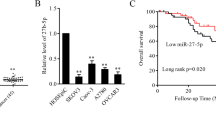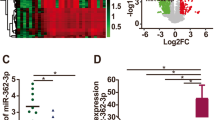Abstract
This study was to investigate the effect of miR-200c on regulation of ovarian cancer cell metastasis potential and explore the underlying molecular events. qRT-PCR was used to analyze the level of miR-200c expression in 48 ovarian cancer and 30 normal ovarian tissue samples. pre-miR-200c was used to manipulate miR-200c expression in ovarian cancer cells for detection of changed phenotypes of tumor cells. Bioinformatics analysis was then used to predict target genes of miR-200c and GO and pathway analyses drew the miR-200c-related gene network. Luciferase reporter assay confirmed the target of miR-200c as ZEB2. Western blot was used to detect gene expressions in ovarian cancer cells. Level of miR-200c expression was much higher in ovarian cancer than in normal ovarian tissues, and miR-200c expression was inversely associated with advanced clinical stage and lymph node metastasis of ovarian cancer (p < 0.01). The database search predicted 186 miR-200c-targeting genes, and GO analysis showed that functions of these target genes were enriched in the protein binding and other biological processes. Furthermore, miR-200c expression inhibited ovarian cancer cell ES-2 migration and invasion capacity by suppression of ZEB2 expression (p < 0.01). Overexpression of miR-200c regulated E-cadherin and vimentin expression in ovarian cancer cells. This study demonstrated high miR-200c expression in ovarian cancer tissues and ZEB2 as a targeting gene of miR-200c, which mediated the effects of miR-200c on regulation of ovarian cancer cell migration and invasion capacity and epithelial-to-mesenchymal transition. Thus, targeting of miR-200c or ZEB2 may serve as a potential therapeutic strategy for control of ovarian cancer.







Similar content being viewed by others
References
Jemal A, Siegel R, Ward E, Hao Y, Xu J, Murray T, Thun MJ. Cancer statistics, 2008. CA Cancer J Clin. 2008;58:71–96.
Nakayama K, Nakayama N, Katagiri H, Miyazaki K. Mechanisms of ovarian cancer metastasis: biochemical pathways. Int J Mol Sci. 2012;13:11705–17.
Sourbier C. Ovarian cancer: emerging molecular-targeted therapies. Biologics. 2012;6:147–54.
Gilabert-Estelles J, Braza-Boils A, Ramon LA, Zorio E, Medina P, Espana F, Estelles A. Role of microRNAs in gynecological pathology. Curr Med Chem. 2012;19:2406–13.
Diaz-Lopez A, Moreno-Bueno G, Cano A. Role of microRNA in epithelial to mesenchymal transition and metastasis and clinical perspectives. Cancer Manag Res. 2014;6:205–16.
Gallo D, Ferlini C, Scambia G. The epithelial-mesenchymal transition and the estrogen-signaling in ovarian cancer. Curr Drug Targets. 2010;11:474–81.
Vergara D, Merlot B, Lucot JP, Collinet P, Vinatier D, Fournier I, Salzet M. Epithelial–mesenchymal transition in ovarian cancer. Cancer Lett. 2010;291:59–66.
Korpal M, Lee ES, Hu G, Kang Y. The miR-200 family inhibits epithelial–mesenchymal transition and cancer cell migration by direct targeting of E-cadherin transcriptional repressors ZEB1 and ZEB2. J Biol Chem. 2008;283:14910–4.
Kurahara H, Takao S, Maemura K, Mataki Y, Kuwahata T, Maeda K, et al. Epithelial–mesenchymal transition and mesenchymal–epithelial transition via regulation of ZEB-1 and ZEB-2 expression in pancreatic cancer. J Surg Oncol. 2012;105:655–61.
Zheng H, Liu JY, Song FJ, Chen KX. Advances in circulating microRNAs as diagnostic and prognostic markers for ovarian cancer. Cancer Biol Med. 2013;10:123–30.
Peinado H, Olmeda D, Cano A. Snail, Zeb and bHLH factors in tumour progression: an alliance against the epithelial phenotype? Nat Rev Cancer. 2007;7:415–28.
Yang J, Weinberg RA. Epithelial–mesenchymal transition: at the crossroads of development and tumor metastasis. Dev Cell. 2008;14:818–29.
Nam EJ, Yoon H, Kim SW, Kim H, Kim YT, Kim JH, et al. MicroRNA expression profiles in serous ovarian carcinoma. Clin Cancer Res. 2008;14:2690–5.
Burk U, Schubert J, Wellner U, Schmalhofer O, Vincan E, Spaderna S, Brabletz T. A reciprocal repression between ZEB1 and members of the miR-200 family promotes EMT and invasion in cancer cells. EMBO Rep. 2008;9:582–9.
Paterson EL, Kolesnikoff N, Gregory PA, Bert AG, Khew-Goodall Y, Goodall GJ. The microRNA-200 family regulates epithelial to mesenchymal transition. Sci World J. 2008;8:901–4.
Schoof CR, Botelho EL, Izzotti A, dos Reis Vasques L. MicroRNAs in cancer treatment and prognosis. Am J Cancer Res. 2012;2:414–33.
Kuhlmann JD, Rasch J, Wimberger P, Kasimir-Bauer S. microRNA and the pathogenesis of ovarian cancer—a new horizon for molecular diagnostics and treatment? Clin Chem Lab Med. 2012;50:601–15.
Nishimura M, Jung EJ, Shah MY, Lu C, Spizzo R, Shimizu M, et al. Therapeutic synergy between microRNA and siRNA in ovarian cancer treatment. Cancer Discov. 2013;3:1302–15.
van Jaarsveld MT, Helleman J, Berns EM, Wiemer EA. MicroRNAs in ovarian cancer biology and therapy resistance. Int J Biochem Cell Biol. 2010;42:1282–90.
S-dL Lin-xia Li, Yang Yi-xia, Wan Xiao-ping. Changes of miR-200c expression in ovarian cancer and its clinical significance. Acad J Sec Mil Med Univ. 2011;32:612–6.
Bendoraite A, Knouf EC, Garg KS, Parkin RK, Kroh EM, O’Briant KC, et al. Regulation of miR-200 family microRNAs and ZEB transcription factors in ovarian cancer: evidence supporting a mesothelial-to-epithelial transition. Gynecol Oncol. 2010;116:117–25.
Hu X, Macdonald DM, Huettner PC, Feng Z, El Naqa IM, Schwarz JK, et al. A miR-200 microRNA cluster as prognostic marker in advanced ovarian cancer. Gynecol Oncol. 2009;114:457–64.
Howe EN, Cochrane DR, Richer JK. The miR-200 and miR-221/222 microRNA families: opposing effects on epithelial identity. J Mammary Gland Biol Neoplasia. 2012;17:65–77.
Gregory PA, Bert AG, Paterson EL, Barry SC, Tsykin A, Farshid G, et al. The miR-200 family and miR-205 regulate epithelial to mesenchymal transition by targeting ZEB1 and SIP1. Nat Cell Biol. 2008;10:593–601.
Park SM, Gaur AB, Lengyel E, Peter ME. The miR-200 family determines the epithelial phenotype of cancer cells by targeting the E-cadherin repressors ZEB1 and ZEB2. Genes Dev. 2008;22:894–907.
Brabletz S, Brabletz T. The ZEB/miR-200 feedback loop—a motor of cellular plasticity in development and cancer? EMBO Rep. 2010;11:670–7.
Mongroo PS, Rustgi AK. The role of the miR-200 family in epithelial-mesenchymal transition. Cancer Biol Ther. 2010;10:219–22.
Valastyan S. Roles of microRNAs and other non-coding RNAs in breast cancer metastasis. J Mammary Gland Biol Neoplasia. 2012;17:23–32.
Ho CS, Yap SH, Phuah NH, In LL, Hasima N. MicroRNAs associated with tumour migration, invasion and angiogenic properties in A549 and SK-Lu1 human lung adenocarcinoma cells. Lung Cancer. 2014;83:154–62.
Iorio MV, Croce CM. MicroRNA profiling in ovarian cancer. Methods Mol Biol. 2013;1049:187–97.
Gheldof A, Hulpiau P, van Roy F, De Craene B, Berx G. Evolutionary functional analysis and molecular regulation of the ZEB transcription factors. Cell Mol Life Sci. 2012;69:2527–41.
Hurteau GJ, Carlson JA, Spivack SD, Brock GJ. Overexpression of the microRNA hsa-miR-200c leads to reduced expression of transcription factor 8 and increased expression of E-cadherin. Cancer Res. 2007;67:7972–6.
Bracken CP, Gregory PA, Kolesnikoff N, Bert AG, Wang J, Shannon MF, Goodall GJ. A double-negative feedback loop between ZEB1-SIP1 and the microRNA-200 family regulates epithelial–mesenchymal transition. Cancer Res. 2008;68:7846–54.
Yu X, Zhang X, Bi T, Ding Y, Zhao J, Wang C, et al. MiRNA expression signature for potentially predicting the prognosis of ovarian serous carcinoma. Tumour Biol. 2013;34:3501–8.
Chen J, Tian W, Cai H, He H, Deng Y. Down-regulation of microRNA-200c is associated with drug resistance in human breast cancer. Med Oncol. 2012;29:2527–34.
Kopp F, Oak PS, Wagner E, Roidl A. miR-200c sensitizes breast cancer cells to doxorubicin treatment by decreasing TrkB and Bmi1 expression. PLoS One. 2012;7:e50469.
Acknowledgments
This study was supported in part by Grants from National Natural Science Foundation of China (81001163), Liaoning Education Department for Scientific and Technological Research Project funds (2009A781), and Shenyang Science and Technology Project funds (F13-221-9-46).
Conflict of interest
The authors declared that there was no conflict of interest in this work.
Author information
Authors and Affiliations
Corresponding author
Rights and permissions
About this article
Cite this article
Lu, Ym., Shang, C., Ou, Yl. et al. miR-200c modulates ovarian cancer cell metastasis potential by targeting zinc finger E-box-binding homeobox 2 (ZEB2) expression. Med Oncol 31, 134 (2014). https://doi.org/10.1007/s12032-014-0134-1
Received:
Accepted:
Published:
DOI: https://doi.org/10.1007/s12032-014-0134-1




